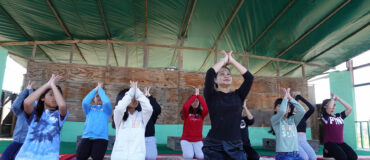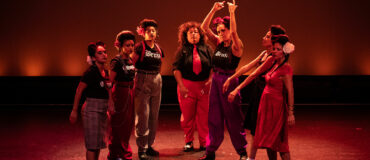Editor’s note: With this article From the Green Room, Dance/USA’s eJournal, begins a conversation on diversity in all its forms. To join the conversation, please comment below, or to contribute an article on the topic, email: journal@nulldanceusa.org. To find others in this series, select “Diversity” at the panel to the right.
By Laura E. Ellis
The red clay earth is caked on the bottom of my dance shoes. My dance clothes are stuck to my body. I’m drenched in sweat, hoarse from singing, and my eyes are filled with tears. I’m in the center of Chitungwiza, a township in Zimbabwe, performing an encore for a huge crowd that is cheering, clapping, and dancing their approval! This is the scene of one of the many performances we gave during our tour to Zimbabwe, the culminating experience of a collaborative journey lead by Deborah Vaughan, artistic director of Dimensions Dance Theater of Oakland, Calif.
****
As a company member of Dimensions Dance Theater, I’ve had the opportunity to take quite a few journeys with Deborah Vaughan — a master artist and one of my mentors. What is most impactful about Vaughan’s approach to choreography is her ability to stay rooted to tradition while creating contemporary dance theater. In-depth research, travel, and bridging cultures through artistic exchanges are at the heart of what she does. The benefit to her dancers is invaluable, as we get to work closely with master teachers and musicians from around the world. We spend weeks to months in master classes and rehearsals thoroughly immersed in the traditional movement — learning about the historical and social significance — songs, music, and choreography. Next, we work with Vaughan blending the traditional language with contemporary forms of modern and jazz movement to build a piece structured with theme, packed with vitality, and enriched with nuance. Vaughan is truly a master at crafting contemporary work that blends traditional dance forms rooted in context … not just fused for effect.
Over my 20 years performing with this company, it has been incredible to see the artistic sharing and bonds of friendship created among the artists and musicians taking these artistic journeys and working on these projects. Some of the collaborators include: Isaas Rojas of Havanna; Lily Cai, who directs her Chinese dance company in San Francisco; Peniel Guerrier, a master of Afro-Haitian and Brazilian dance; the great South African jazz and Afrobeat musician Hugh Masekela; Zimbabwean mbira musician Stella Chiweshe; Cuban composer and bandleader Omar Sosa; and Shanghai-born, San Francisco-based composer Gang Situ. Each project was unique and an unforgettable learning experience. Experiences that inspired me to co-found a non-profit and to co-present the Black Choreographers Festival: Here and Now in San Francisco to help support the next generation of artists doing contemporary work rooted in dance forms and music of the African Diaspora — Nora Chipaumire, Adia Whitaker, Amara Tabor-Smith, and Latanya d. Tigner … to name a few. Each of these artists has strong ties to the Bay Area and these choreographers follow a similar approach: valuing deep research, travel, and collaboration to build artistic bonds and impactful works of art.
An artist-centered sharing of culture and creativity is a practice embraced by many choreographers; serving an essential purpose in fortifying artistic inspiration and creative explorations, stimulating the artistic journey from the studio to the stage, such examples in the Bay Area include: Long River High Sky, Alonzo King’s Lines Ballet’s collaborative work with Shaolin monks; India Jazz Suites, the dynamic cross-cultural conversation between Kathak master Pandit Chitresh Das and rhythm tap dynamo, Jason Samuels Smith; Tears of Rock, Anne Bluethenthal’s dance-theater work that brought together Israeli and Palestinian folk dance and music with contemporary modern dance and Bluethenthal’s text. These types of collaborations are suggestive of the way best practices can build artistic bridges that support contextualizing work. These practices can benefit any community of artists or arts organizations interested in the process of deep research and cross-cultural collaboration over mere appropriation or novel contributions to project-based work. Artists can look to their own communities to find artistic partners that see the value of the journey: deep-rooted collaboration and artistic sharing across cultures, enriching diverse works of art presented in the small and large spaces throughout our nation.
****
Dancing on the red clay earth in Chitungwiza will stand out as one of the more memorable performances of my life. More profound, though, are the words a Zimbabwean elder spoke to me after that performance: “It was so good to see this performance. We only know about the Black American dance we see in the music videos. I was surprised to see you dance such a beautiful story. It made me proud to see this. Please keep doing what you are doing!”
“Down the Congo Line” is the project we are working on right now. Four choreographers: Herve (Kayos) Makaya, Isaura Oliveira, Cheo Rojas, and Latanya d. Tigner; four regions represented: Congo, Brazil, Cuba, and New Orleans; a host of musicians and singers from each region; and one company of dancers, Dimensions Dance Theater, taking our newest journey with Ms. Deborah Vaughan. Here we go!!!
Laura E. Ellis is a principal dancer with Dimensions Dance Theater in Oakland, Calif. She also serves as executive director of the African & African-American Performing Arts Coalition (AAAPAC). Ellis is a co-presenter of the Black Choreographers Festival Here & Now (BCF) each year in San Francisco and she serves as senior faculty/lecturer at California State University, East Bay in the Theater & Dance Department.
____
We accept submissions on topics relevant to the field: advocacy, artistic issues, arts policy, community building, development, employment, engagement, touring, and other topics that deal with the business of dance. We cannot publish criticism, single-company season announcements, and single-company or single artist profiles. Additionally, we welcome feedback on articles. If you have a topic that you would like to see addressed or feedback, please contact communications@danceusa.org.
Disclaimer: Opinions expressed in guest posts do not necessarily represent the viewpoints of Dance/USA.





